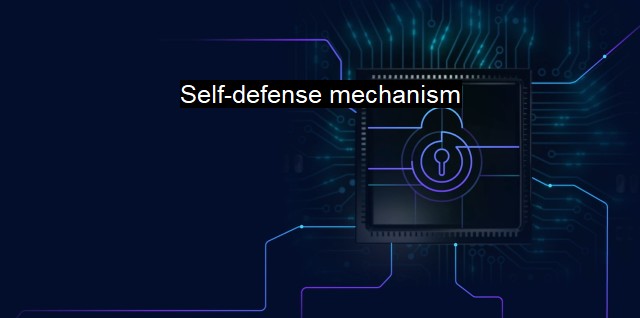What is Self-defense mechanism?
Critical Components of Cybersecurity: The Significance and Types of Self-Defense Mechanisms in Antivirus Software
Self-defense mechanisms are critical components of cybersecurity and antivirus software. They are designed to detect and prevent attempts by malware and other cyber threats to disable or circumvent security measures. These defenses are especially important in today's increasingly complex cyber environment, where attackers are constantly evolving and adapting their tactics.Self-defense mechanisms refer to a set of techniques and strategies that software developers use to prevent cybercriminals or hackers from accessing or disabling their software. The goal is to detect and prevent any malicious activity before it can cause harm to the computer or the network. Security experts often classify self-defense mechanisms in two broad categories: proactive and reactive.
Proactive defenses are tools and strategies that aim to stop malware from entering the system in the first place. This is accomplished through various techniques, such as firewalls, spam filters, and intrusion detection systems. For instance, a desktop antivirus program can scan all incoming files and attachments to ensure they do not contain any harmful code. By identifying and blocking them before they can act on the system, this type of self-defense helps reduce the likelihood of a successful cyber attack.
Reactive self-defense mechanisms, on the other hand, are designed to prevent attackers from disabling or bypassing security measures once they have gained access. Some common reactive defenses include sandboxing, where a program is run in a virtual environment to test its behavior before it is allowed to run on the system. Another example is code obfuscation, in which the program is deliberately made to look more complicated than it is, as this makes it more difficult for attackers to reverse-engineer it.
Self-defense mechanisms employ several techniques to ensure their effectiveness. One such approach is called diversification, where the software is split into smaller, independent components that can each function on their own. An example might be separating the CPU, memory and input-output functionalities. This approach makes it more difficult for an attacker to bypass all security defenses at once and gain control of the system. frequent updates to software, which include bug fixes and security patches, help ensure that any undiscovered vulnerabilities in the system are quickly addressed.
Another tactic used by self-defense mechanisms is a technique called intrusion prevention. This method relies on watching network traffic for suspicious activity and preventing it in real-time. Intrusion prevention systems typically have several sensors configured to detect and block protocols that are explicitly designed to bypass antivirus products or other security measures.
One such method is signature detection. Malware typically has a unique signature denoting specific characteristics, giving it away as malicious. Antivirus software uses these signatures to detect and neutralize known malware on the system. Hackers often try to bypass signature detection by writing polymorphic code that mutates or fades, making it more challenging to detect. To counteract this, security researchers have created heuristics-based algorithms that can deduce whether a specific code is malicious or not, regardless of its signature.
Behavior-based monitoring represents another approach to cybersecurity defense. Instead of blocking a pattern of specified words, the software actively takes preventive action when it performs an abnormal or unfamiliar action. clicking a toolbar button repeatedly in a unique program or launching a cloud-based service during the middle of the night could trigger the action.
Behavior-based monitoring helps eliminate and shorten the amount of time between discovering a new attack vector and building a similar prevention software patch. Machine learning and other artificial intelligence techniques have been applied to improve the accuracy of behavior-based protection strategies.
self-defense mechanisms are an essential part of cybersecurity and antivirus tools. These defenses involve techniques such as signature-based detection, intrusion prevention, and behavior-based monitoring. With their help, users can protect themselves and their data from a wide range of cyber threats, keeping both their systems and their peace of mind secure. As cybercriminals continue to adapt to user and software protections, the continued development of self-defense mechanisms will be critical to meet those threats.

Self-defense mechanism FAQs
What is a self-defense mechanism in cybersecurity?
A self-defense mechanism in cybersecurity is a program or feature designed to protect against unauthorized access and hacking attempts.What are some examples of self-defense mechanisms in antivirus software?
Antivirus software may use active scanning, behavior-based detection, and code emulation to identify and block suspicious activity. It may also have a firewall, intrusion prevention system, and sandboxing capabilities to help prevent attacks.How does a self-defense mechanism work in practice?
When a program or system is attacked, the self-defense mechanism will immediately identify and respond to the threat. It may do this by blocking the attacker's IP address, terminating malicious processes or activities, or alerting the user or security team.Why is a self-defense mechanism important for cybersecurity?
A self-defense mechanism is important for cybersecurity because it helps prevent unauthorized access, theft, and corruption of sensitive data. It also adds an extra layer of protection against attacks and can help minimize the damage caused by successful breaches.| | A | | | B | | | C | | | D | | | E | | | F | | | G | | | H | | | I | | | J | | | K | | | L | | | M | |
| | N | | | O | | | P | | | Q | | | R | | | S | | | T | | | U | | | V | | | W | | | X | | | Y | | | Z | |
| | 1 | | | 2 | | | 3 | | | 4 | | | 7 | | | 8 | | |||||||